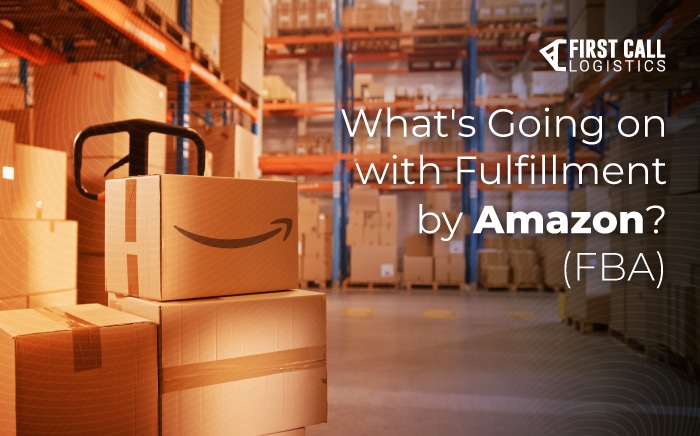What’s Going on with Fulfillment by Amazon? (FBA)

If you’re an Amazon seller or otherwise connected to the world of ecommerce, you’ve probably heard of Fulfillment by Amazon (FBA). The popular service allows third-party sellers to store products in Amazon’s fulfillment centers and have them shipped to customers using Amazon’s logistics network — useful, no?
You also may have noticed some recent changes and controversies surrounding Amazon’s deteriorating user experience, which is why today we’re exploring what’s going on with Fulfillment by Amazon and how it affects sellers and customers alike.
First, What is Fulfillment by Amazon?
Fulfillment by Amazon launched in 2006, offering limited storage and shipping resources to third-party sellers on Amazon’s digital marketplace. The service allows sellers to store products in Amazon warehouses and use the ecommerce giant’s own workers to fill and ship orders placed through Amazon’s massive online marketplace. Should any products need to be returned, Amazon customer service would also assist with the reverse logistics process.
Using FBA requires an Amazon selling account and a “Seller Central” profile to create listings for products to be added to Amazon’s catalog; these products are then mailed to one of Amazon’s many fulfillment centers. Once Amazon receives these products, they are made available for purchase on Amazon’s digital marketplace.
Upon conversion, Amazon will pick, pack and ship the product out to the customer, manage the returns process if the customer is unsatisfied and notify sellers when stock is running low.
How Much Does Fulfillment by Amazon Cost?
In exchange for these services, Amazon charges the seller storage and fulfillment fees. These fees vary depending on the size and weight of the product, as well as the duration of storage in Amazon’s warehouses. In general, fees fall into these two categories:
- Fulfillment fees – Applies to each unit that’s picked, packed and shipped from the fulfillment center.
- Storage fees – Determined by calculating the average daily volume of your inventory, then charging for the average space used to store the items. Storage fees also fluctuate depending on the time of the year.
Here’s where things start getting muddy. As of April 2023, Amazon will tack on additional “Storage Utilization Surcharges” to items stored longer than six months. The surcharge is both a reaction to Amazon’s declining ecommerce growth rate and a calculated risk, pressuring the majority of existing sellers to alter their business models (storing at least six months of inventory has long been considered best practice for Amazon sellers).
What Are the Benefits of Using Fulfillment by Amazon?
Using FBA grants access to Amazon’s warehousing and shipping networks. Amazon’s established processes can get products packaged and out the door faster than most sellers are capable of doing on their own. FBA also gives brands direct access to Amazon’s vast customer base.
For customers, FBA offers fast and reliable shipping through Amazon Prime and convenient customer service options.
What Are the Downsides of Using Fulfillment by Amazon?
Amazon is under fire for recent inventory chaos, which in turn causes headaches for just about everyone. While utilizing FBA has its advantages, brands can expect a lesser degree of quality control over their products when entrusting their storage and shipping to Amazon’s warehouses. Amazon fulfillment is strictly picking and packing — not necessarily inspecting each product to ensure it’s good quality — and lately, the picking and packing haven’t exactly been on point either.
Companies working exclusively through FBA also lose the ability to customize product packaging. Products shipped using FBA arrive in Amazon boxes with Amazon branding — many customers don’t even realize they aren’t buying something directly from Amazon.
Fluctuating storage and fulfillment fees (not to mention seasonal ebbs and flows in product demand) tend to complicate things further. Sending Amazon too much inventory will result in higher fees, but too little could result in stockouts, lost sales and annoyed customers.
What Separates a 3PL Provider from FBA?
Fulfillment by Amazon and third-party logistics (3PL) services are both popular options for ecommerce sellers looking to outsource their order fulfillment and logistics operations. While they may seem similar at first glance, there are some key differences between the two:
- Ownership and control. With FBA, Amazon owns and operates the fulfillment center, and the seller has limited control over the logistics process. In contrast, a 3PL service is typically owned by a third-party provider, and the seller retains more control over the fulfillment process, including choosing carriers and shipping methods.
- Referral Fees. FBA and 3PLs each charge for storage and shipping services, but Amazon also takes a cut of every sale in what the company terms a “referral fee.” This can range between 8-15% of each sale made through the platform.
- Branding. With FBA, Amazon is the face of the fulfillment and shipping process, which can prove a major downside for sellers. With 3PL services, sellers use their own branding and packaging to create a more personalized experience for their customers.
- Volume requirements. FBA does not have any minimum volume requirements, making it accessible to sellers of all sizes. Some 3PL services may have minimum volume requirements, which can be a barrier to entry for smaller sellers.
Overall, FBA may be a good fit for sellers looking for a hands-off fulfillment experience with access to Amazon’s vast customer base, while 3PL services appeal to sellers looking for more control over the logistics process and flexibility in both pricing and branding.
Streamline Delivery with Flexible Storage Solutions
Speedy delivery is crucial to any growing business. First Call’s Warehousing & Distribution Services can help establish resilient supply chains, deliver products on time and achieve long-term business goals.